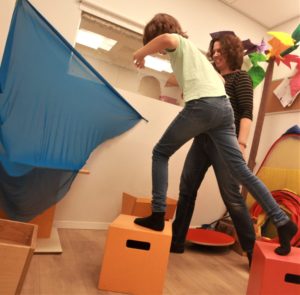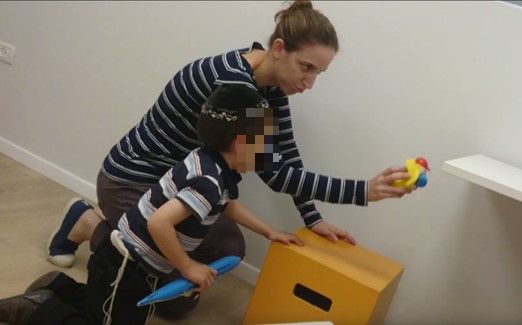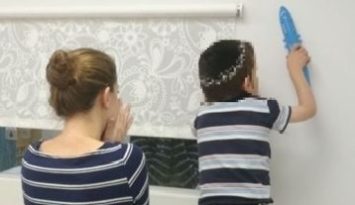General Description:
Play that combines sensorimotor play and the use of real-life space, objects, and people in all dimensions, including height, distance, etc. The idea is to create an imaginary world around the room that parallels an inner world.

Objectives:
- Heighten body awareness and awareness of the self in relation to space.
- Explore mobility and movement in space in a continuous and organized manner
- With progress, increase awareness between the body and moving objects in the space, improve the child’s ability to track body motion in relationship to the environment.
- Amplification of imaginary play skills while keeping a calm and organized conduct in the space.
Imaginary-Spatial Play is suited for
- Children who are prone to sitting and lying down
- Children with an over-focus on material objects
- Children who don’t have a tendency to move often in space
- Frantic or distracted children with unorganized movement in space
- Children with difficulty in visual-spatial processing – difficulty in solving problems in space, with poor or low body awareness, and difficulty orienting the body in relation to space or other people
- Children with limited imaginative play
Guidelines
- Build an imaginary world, realizing the full real space in the play area in order to expand the inner space (the world of imagination).
- Define locations of points in the real space to support the imaginary space. For example, decide where the bed, kitchen, and playroom go, or where the mountain (a couch) and the lake (a blue sheet) should be.
- Encourage the child to move and explore in the space.
Tools:
- Spatial thinking, using spatially-orienting terminology like opposite, below, above, near, behind.
- Using furniture and the corners of the room as an opening to a symbolic world (a sofa as a pirate boat, a cave under a chair, etc.).
- Building a route from home furniture to an imaginary scene (e.g., a road to get to the King’s Castle or a thief fleeing from a police officer to a cave under a covered table).
Why is it useful? This type of play allows for establishing a basis for emotional developmental stages 4-5 in the DIR model – movement planning, problem-solving, the development of complex communication, emotional ideas, abstract thinking, and imaginary play.
Examples:
Example 1 D., who experiences difficulty in imaginary-spatial play, finds a tiger doll and begins a stimulating game that is visually over-focused on the doll, without connecting to the mother or therapist. Encouraged by the therapist, the mother put on a mouse hat and runs as if a scared mouse to hide under a table in the corner of the room in a “cave.” The powerful, playful effect of the mother’s imaginary-spatial play and the expression of her frightened face manage to catch her child’s attention, who in response approaches her with the tiger doll as if hunting her and roars
Other examples of imaginary play: encouraging the child to climb on the chair while pretending that it is the second floor of the house, defining the corners of the room as different imaginary areas (e.g., shower, bedroom, and kitchen, or the monster area and the safe area, etc.), creating hiding places and more.
Examples of structured play –involve awareness of the body’s orientation in space relating to moving objects and monitoring the environment.
Examples include looking for the treasure, “Red Light Green Light,” football, tag, catch.


